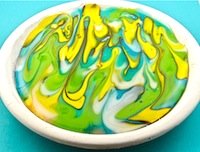Hot Glass Combing
Ideas for hot glass combing in a saucer or stainless steel mold at high temperature in a fusing glass kiln.
The techniques, tools and safety preparations outlined here are the same as those on the glass combing page, please refer to this page for further glass combing information.
Unlike the preparation and kiln set-up on the glass combing page this hot glass combing example does not use strips but relies on scraps of glass placed in a saucer or mold.
A terra-cotta saucer has been used to contain the scraps for this project.
The saucer must be heavily kiln washed as it will be exposed to high temperatures in the glass fusing kiln.
Good quality terra cotta should be used as inferior saucers may crack.

Always place the saucer on a kiln washed shelf as a protective measure.
As an alternative stainless steel rings or squares are available which will overcome any quality issues.
Stainless steel should be lined with 1/8" inch fiber paper and placed on a heavily kiln washed shelf. Do not use thinfire paper for the mold lining or on the shelf as it will break down due to the high temperatures.
The following details apply to most fusedglass combing projects.
Combing Tools
A combing tool or rake for fused glass combing is usually a metal rod bent on one end with a blunt tip. For safety reasons it should be equipped with a wooden handle.
Full metal rods should be avoided as electricity may be present if the rod accidentally meets a hot kiln element, even if the kiln has been switched off.
Rods of different lengths can be purchased or made. Some people used stainless steel barbecue tools for combing. Stainless steel or brass can be used, do not use copper or aluminum.
Rods should be about two to three feet long depending on the size of your warm glass kiln. A metal hook can be screwed into a broom handle to make a combing rake.
Rods like this will need to be soaked for twenty four hours prior to each combing session to ensure that the wood does not catch fire.
Safety
Because fused glass combing is carried out at high temperature it is essential that proper safety precautions be observed.
Do not wear synthetic clothing, wool or cotton are best, long sleeve shirt or protective jacket should be worn.
Heatproof gloves are essential, Kevlar or Zetex gloves are recommended. Remove dangling jewelry and tie back long hair.
To block infrared radiation glass kiln shaded safety glasses must be worn.
A full length face safety shield is another safety item that can be worn over the kiln glasses.
A bucket of water.
If you have not worked at high temperatures before it is advisable to work with an assistant for safety reasons.
Preparation
Place small pieces of scrap glass in the saucer until the base is nicely covered. Mound the glass up in the center of the saucer so that it will flow nicely across the stack.
Do not use too many colors as some colors will become a muddy color at high temperature. Lighter colors are the best as dark colors will dominate the other colors.
Color selection can sometimes be a matter of trial and error. The glass used in this example is Spectrum 96 yellow, green, blue, white and clear.
Place saucer in glass kiln, as the glass pieces are small bring temperature up to 1100° F (593° C), hold for 15 minutes bring up to 1650-1700° F (899-927° C).
Combing
Switch off kiln, being careful not to touch the sides of the kiln reach in with your combing tool and draw the tip firmly across the glass, do not push the tool down through the glass and create holes.
You can either push the tool or pull it towards you. It is possible after some practice to use two rods one pulling, one pushing. It's easier to start with one.
Pull in a straight line and begin to create your pattern, after a couple of passes the glass will begin to cool. Close the kiln door and re-heat, repeat the combing process until satisfied.
Glass may stick to the rod tip, hold the tool above the glass and remove from the kiln.
Dip rod into cold water, dry the rod before commencing combing again.
When you are satisfied with your pattern let the glass sit at about 1500 F (816C) to smooth out the marks left from the rod.
The glass should now be cooled cool down through your normal annealing cycle.
The glass can be sliced on a saw for inclusion in other glass fusing projects.

Return From Hot Glass Combing To Glass Fusing Projects
Return To Home Page
